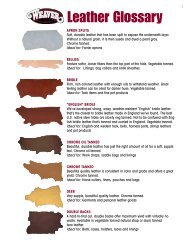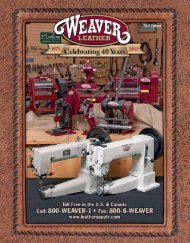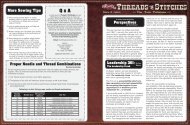Bitology - Weaver Leather
Bitology - Weaver Leather
Bitology - Weaver Leather
You also want an ePaper? Increase the reach of your titles
YUMPU automatically turns print PDFs into web optimized ePapers that Google loves.
HACKAMORES<br />
A hackamore may look relatively simple in its construction of a noseband connected to a headstall and reins;<br />
however, to control a horse without a mouthpiece takes patience and training. Hackamores were introduced<br />
to America in the early 1800s by Spanish vaqueros. Since then, many trainers have found great value in<br />
implementing hackamores into their training regimens. Some trainers may start young horses in a hackamore<br />
while others may introduce the hackamore after starting a horse off in a snaffle. Again, it is a matter of preference.<br />
Bosal and mechanical hackamores are often also used on older horses, bit-sour horses or horses with damaged<br />
bars and/or tongues.<br />
6<br />
Proper placement is important when fitting a hackamore. Adjusted too low, it will hinder the horse’s breathing. It<br />
should sit on the gristly part of your horse’s nose, approximately 4" from the top of the nasal cavity. Size of the<br />
hackamore is also important. The wider/thicker the nosepiece, the more pressure is dispersed, thereby making it<br />
gentler than a thinner nosepiece. There are two common types of hackamores used today:<br />
Bosal Hackamore - commonly used for training<br />
This type of hackamore consists of a bosal (braided noseband), headstall (bosal hanger) and,<br />
traditionally, horsehair reins called a mecate [muh-kah-tee]. Braided nylon mecates are also<br />
used, so it typically depends on preference. Bosal hackamores work on the bridge of the nose,<br />
the sensitive tissue along the nose and the chin.<br />
Bosal hackamores can teach a horse to be softer in the face and carry itself so its poll, spine<br />
and body are balanced. When you pick up on the mecate, the sensitive nerves in the soft tissue<br />
on either side of the nose are lightly squeezed to achieve the desired pressure and results.<br />
Mechanical Hackamore - commonly used in trail riding, team roping and other speed events<br />
Mechanical hackamores work off of leverage via a noseband, curb strap/chain and shanks. As<br />
with curb bits, the longer the shanks, the more leverage you will have. These hackamores work<br />
on the nose, chin, lower jaw and the poll.<br />
COMMON BIT QUESTIONS<br />
Where does the bit fit in a horse’s mouth?<br />
Bits are designed to fit with the mouthpiece across and on top of the tongue and resting on the bars of the mouth<br />
between the incisors (front teeth) and premolars (back teeth).<br />
What is the standard size mouthpiece for a horse?<br />
Mouthpieces measuring 5" are the standard for most horses, while the standard for ponies is 4-1/2". Draft horses<br />
normally take a 6"-6-1/2" mouthpiece.<br />
How do I know which bit is the right one for my horse?<br />
Every horse is different and so is every rider. Bitting a horse properly is a combination of matching up the bit with<br />
both your horse AND how you control your hands. If your horse is tossing his head a lot, for example, it could be a<br />
result of how hard you are pulling on the reins combined with the bit working too much on his palate or pinching.<br />
The bit could also be putting too much pressure on your horse’s bars, which can cause discomfort. These are just<br />
a couple examples, but there are a many factors that go into choosing the right bit. We encourage you to read our<br />
complete <strong>Bitology</strong> section to gain a general understanding of bits or contact a trusted trainer in your area if you are<br />
having trouble finding the right bit that works well for both you and your horse.<br />
What are the long term consequences of using an incorrect or too severe bit on my horse?<br />
Eventually, you will end up damaging the bars, tongue or palate of your horse’s mouth which can deaden the<br />
nerves. If that happens, you will never again be able to rely on a bit that’s designed to specifically work on those<br />
areas of the mouth. A damaged mouth is one reason people go to hackamores down the road. One thing to always<br />
keep in mind is the quieter your hands, the less severe any bit will be. We recommend asking your trainer or<br />
a trusted trainer in your area about what bit you should change to.







